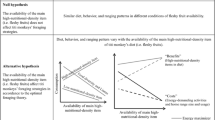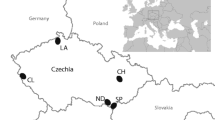Abstract
Understanding the dynamics of animal responses to heterogeneity of food resources in modified landscapes is crucial for the conservation of threatened species. We evaluated dietary strategies of the Northern Mealy Amazon in a modified landscape of tropical moist forest in Los Chimalapas, Mexico. We established 30 phenology transects (200 × 6 m) to determine food resource availability in primary evergreen, riparian, and secondary forests during the parrot breeding (March–April) and non-breeding (August–September) seasons, and determined parrot diet by observations of foraging individuals. We found spatiotemporal variation in food resource availability, with significantly greater food resource availability in the breeding season compared to the non-breeding season, and significantly fewer resources in secondary forest. Parrots consumed mainly seeds of a variety of plant species, and presented a medium dietary niche during the breeding season. Nevertheless, parrots foraged predominantly in primary forest where they demonstrated dietary selectivity, and rarely foraged in secondary forest where they consumed resources according to availability. We found evidence that Northern Mealy Amazons employ hierarchical criteria in habitat use and resource selection, adjusting foraging strategies according to resource availability. This learning-by-consequence foraging model may enable parrots to rapidly adapt to spatiotemporal variations in food resource availability. Primary tropical moist forest may be a key habitat type for Northern Mealy Amazons during the breeding season as this provides an abundance of food resources for parrots when they are raising young.
Zusammenfassung
Lernen durch Verstärkung-Ernährungsmodell bei Guatemalaamazonen in einer modifizierten Landschaft von tropischem Feuchtwald.
Für den Schutz bedrohter Arten ist entscheidend, die Dynamik der Reaktionen von Tieren auf die Heterogenität von Nahrungsressourcen in modifizierten Landschaften zu verstehen. Wir haben Ernährungsstrategien der Guatemalaamazone in einer modifizierten Landschaft von tropischem Feuchtwald in Los Chimalapas, Mexiko, untersucht. Wir haben 30 Phänologie-Transekte (200 × 6 m) etabliert, um die Verfügbarkeit von Nahrungsressourcen in immergrünen, an Flussufern gelegenen Primär- und Sekundärwäldern während (März und April) und außerhalb (August und September) der Brutzeit der Papageien zu ermitteln, und haben die Nahrung der Papageien durch die Beobachtung fressender Individuen bestimmt. Wir fanden räumlich-zeitliche Schwankungen in der Nahrungsverfügbarkeit, mit signifikant höherer Nahrungsverfügbarkeit während als außerhalb der Brutzeit, sowie signifikant weniger Ressourcen in Sekundärwäldern. Die Papageien fraßen hauptsächlich die Samen einer Vielzahl von Pflanzenarten und wiesen während der Brutzeit eine mittlere Nahrungsnische auf. Nichtsdestotrotz suchten die Papageien hauptsächlich im Primärwald nach Nahrung, wo sie Nahrung gezielt auswählten, und fraßen nur selten in Sekundärwäldern, wo sie Ressourcen gemäß ihrer Verfügbarkeit konsumierten. Wir fanden Hinweise, dass Guatemalaamazonen bei Habitatnutzung und Ressourcenwahl hierarchische Kriterien anwendeten und ihre Ernährungsstrategien an die Ressourcenverfügbarkeit anpassten. Dieses Lernen durch Verstärkung-Ernährungsmodell könnte es den Papageien ermöglichen, sich schnell an räumlich-zeitliche Variationen in der Nahrungsverfügbarkeit anzupassen. Feuchte tropische Primärwälder könnten ein Schlüssel-Habitattyp für Guatemalaamazonen während der Brutzeit sein, da sie eine Fülle von Nahrung für die Papageien zur Zeit der Jungenaufzucht bieten.



Similar content being viewed by others
References
Bates D, Maechler M, Bolker B, Walker S (2015) Fitting linear mixed-effects models using lme4. J Stat Softw 67:1–48
Berg KS, Socola J, Angel RR (2007) Great Green Macaws and the annual cycle of their food plants in Ecuador. J Field Ornithol 78:1–10
BirdLife International (2017) Amazona guatemalae. http://www.birdlife.org. Accessed 14 January 2017
Bjork R (2004) Delineating patterns and process in tropical lowlands: Mealy Parrot migration dynamics as a guide for regional conservation planning. Dissertation, Oregon State University
Bonadie WA, Bacon PR (2000) Year-round utilisation of fragmented palm swamp forest by Red-bellied Macaws (Ara manilata) and Orange-winged Parrots (Amazona amazonica) in the Nariva Swamp (Trinidad). Biol Conserv 95:1–5
Boyes RS, Perrin MR (2009) The feeding ecology of Meyer’s Parrot Poicephalus meyeri in the Okavango Delta, Botswana. Ostrich 80:153–164
Boyes RS, Perrin MR (2010) Aerial surveillance by a generalist seed predator: food resource tracking by Meyer’s Parrot Poicephalus meyeri in the Okavango Delta, Botswana. J Trop Ecol 26:381–392
Bullock SH, Solis-Magallanes JA (1990) Phenology of canopy trees of a tropical deciduous forest in Mexico. Biotropica 22:22–35
Byers CR, Steinhorst RK, Krausman PR (1984) Clarification of a technique for analysis of utilization-availability data. J Wildl Manage 48:1050–1053
Chapman CA, Chapman LJ, Wrangham R, Hunt K, Gebo D, Gardner L (1992) Estimators of fruit abundance of tropical trees. Biotropica 24:527–531
Chapman CA, Wrangham R, Chapman LJ (1994) Indices of habitat-wide fruit abundance in tropical forests. Biotropica 26:160–171
Clark CW, Mangel M (1984) Foraging and flocking strategies: information in an uncertain environment. Am Nat 123:626–641
Colwell RK, Futuyma DJ (1971) On the measurement of niche breadth and overlap. Ecology 52:567–576
Contreras-González AM, Rivera-Ortíz FA, Soberanes-González C, Valiente-Banuet A, Arizmendi MC (2009) Feeding ecology of Military Macaws (Ara militaris) in a semi-arid region of central Mexico. Wilson J Ornithol 121:384–391
de Jong B, Anaya C, Masera O, Olguin M, Paz F, Etchevers J, Martinez RD et al (2010) Greenhouse gas emissions between 1993 and 2002 from land-use change and forestry in Mexico. For Ecol Manage 260:1689–1701
De Labra-Hernández MA, Renton K (2016) Importance of large, old primary forest trees in nest-site selection by the Northern Mealy Amazon (Amazon guatemalae). Trop Conserv Sci 9:1–10. https://doi.org/10.1177/1940082916680361
De Labra-Hernández MA, Renton K (2017) Factors influencing density of the Northern Mealy Amazon in three forest types of a modified rainforest landscape in Mesoamerica. Avian Conserv Ecol 12(1):5. https://doi.org/10.5751/ACE-00957-120105
Díaz S, Kitzberger T, Peris S (2012) Food resources and reproductive output of the Austral Parakeet (Enicognathus ferrugineus) in forest of northern Patagonia. Emu 112:234–243
FAO (2015) Global forest resources assessment. Food and Agriculture Organization of the United Nations, Rome
Forshaw JM (1989) Parrots of the world, 3rd (revised) edn. Lansdowne Editions, Melbourne
Galetti M (1993) Diet of the Scaly-headed Parrot (Pionus maximiliani) in a semideciduous forest in Southeastern Brazil. Biotropica 25:419–425
Greene TC (1998) Foraging ecology of the Red-crowned Parakeet (Cyanoramphus novaezelandiae novaezelandiae) and Yellow-crowned Parakeet (C. auriceps auriceps) on Little Barrier Island, Hauraki Gulf, New Zealand. N Z J Ecol 22:161–171
Higgins ML (1979) Intensity of seed predation on Brosimum utile by Mealy Parrots (Amazona farinosa). Biotropica 11:80
Hurlbert SH (1978) The measurement of niche overlap and some relatives. Ecology 59:67–77
Johnson MD (1980) The comparison of usage and availability measurements for evaluating resource preference. Ecology 61:65–71
Jones J (2001) Habitat selection studies in avian ecology: a critical review. Auk 118:557–562
Krebs CJ (1999) Ecological methodology, 2nd edn. Addison-Welsey, Menlo Park
Lenth RV (2016) Least-squares means: the R package lsmeans. J Stat Softw 69:1–33
Levey DJ (1988) Spatial and temporal variation in Costa Rican fruit and fruit-eating bird abundance. Ecol Monogr 58:251–269
Levey DJ, Stiles FG (1992) Evolutionary precursors of long-distance migration: resource availability and movement patterns in Neotropical land birds. Am Nat 140:447–476
Levins R (1968) Evolution in changing environments. Princeton University Press, Princeton
Loiselle BA, Blake JG (1991) Temporal variation in birds and fruits along an elevational gradient in Costa Rica. Ecology 72:180–193
MacArthur R, Levins R (1967) The limiting similarity, convergence, and divergence of coexisting species. Am Nat 101:377–385
MacArthur RH, Pianka ER (1966) On optimal use of a patchy environment. Am Nat 100:603–609
Martínez-Pacheco AI (2012) Monitoreo del cambio de uso de suelo en Los Chimalapas 2000–2003. In: Ortega del Valle D, Carranza-López T, Martínez-Pérez J (eds) Una mirada desde el corazón de la jícara de oro. Experiencias de conservación en la Selva Zoque de Los Chimalapas. WWF México, Oaxaca, pp 86–94
Matuzak GD, Bezy MB, Brightsmith DJ (2008) Foraging ecology of parrots in a modified landscape: seasonal trends and introduced species. Wilson J Ornithol 120:353–365
Morellato LPC, Camargo MGG, Gressler E (2013) A review of plant phenology in South and Central America. In: Schwarts MD (ed) Phenology: an interactive environmental science, 2nd edn. Springer, New York, pp 91–113
Mulwa RK, Neuschulz EL, Böhning-Gaese K, Schleuning M (2012) Seasonal fluctuations of resource abundance and avian feeding guilds across forest–farmland boundaries in tropical Africa. Oikos 122:524–532
Neu CW, Byers CR, Peek JM (1974) A technique for analysis of utilization-availability data. J Wildl Manage 38:541–545
Provenza FD, Cincotta RP (1993) Foraging as a self-organizational learning process: accepting adaptability at the expense of predictability. In: Hughes RN (ed) Diet selection: an interdisciplinary approach to foraging behavior. Blackwell, Oxford, pp 78–101
R Development Core Team (2017) R: a language and environment for statistical computing. R Foundation for Statistical Computing, Vienna, Austria. http://www.R-project.org/ Accessed 20 February 2017
Ragusa-Netto J (2006) Dry fruits and the abundance of the Blue-and-yellow Macaw (Ara ararauna) at a cerrado remnant in central Brazil. Ornitol Neotrop 17:491–500
Ragusa-Netto J (2007) Nectar, fleshy fruits and the abundance of parrots at a gallery forest in the southern Pantanal (Brazil). Stud Neotrop Fauna E 42:93–99
Ragusa-Netto J (2008) Yellow-chevroned Parakeet (Brotogeris chiriri) abundance and canopy foraging at a dry forest in western Brazil. Stud Neotrop Fauna E 43:99–105
Renton K (2001) Lilac-crowned Parrot diet and food resource availability: resource tracking by a parrot seed predator. Condor 103:62–69
Renton K (2006) Diet of adult and nestling Scarlet Macaws in southwest Belize, Central America. Biotropica 38:280–283
Renton K, Salinas-Melgoza A, De Labra-Hernández MA, de la Parra-Martínez SM (2015) Resource requirements of parrots: nest site selectivity and dietary plasticity of Psittaciformes. J Ornithol 156:S73–S90. https://doi.org/10.1007/s10336-015-1255-9
Robinet O, Bretagnolle V, Clout M (2003) Activity patterns, habitat use, foraging behavior and food selection of the Ouvéa Parakeet (Eunymphicus cornutus uvaeensis). Emu 103:71–80
Rzedowsky J (1978) Vegetación de México. Limusa, Mexico City
Saunders DA (1982) The breeding behavior and biology of the short-billed form of the White-tailed Black Cockatoo Calyptorhynchus funereus. Ibis 124:422–455
Saunders DA (1986) Breeding season, nesting success and nestling growth in Carnaby’s Cockatoo, Calyptorhynchus funereus latirostris, over 16 years at Coomallo Creek, and a method for assessing the viability of population in other areas. Aust Wildl Res 13:261–273
Saunders DA (1990) Problems of survival in an extensively cultivated landscape: the case of Carnaby’s Cockatoo Calyptorhynchus funereus latirostris. Biol Conserv 54:277–290
Schoener TW (1971) Theory of feeding strategies. Annu Rev Ecol Syst 2:369–404
Symes CT, Perrin MR (2003) Seasonal occurrence and local movements of the Grey-headed (Brown-necked) Parrot Poicephalus fuscicollis suahelicus in southern Africa. Afr J Ecol 41:299–305
Torres-Colín R (2004) Tipos de vegetación. In: García-Mendoza AJ, Ordoñez MJ, Briones-Salas M (eds) Biodiversidad de Oaxaca, Instituto de Biología, UNAM, Fondo Oaxaqueño para la Conservación de la Naturaleza. WWF México, Mexico City, pp 105–117
Trejo I (2004) Clima. In: García-Mendoza AJ, Ordoñez MJ, Briones-Salas M (eds) Biodiversidad de Oaxaca, Instituto de Biología, UNAM, Fondo Oaxaqueño para la Conservación de la Naturaleza. WWF México, Mexico City, pp 67–85
White LJT (1994) Patterns of fruit-fall phenology in the Lope Reserve, Gabon. J Trop Ecol 10:289–312
Zar JH (1999) Biostatistical analysis, 4th edn. Prentice Hall, Upper Saddle River
Zuur AF, Ieno EN, Walker NJ, Saveliev AA, Smith GM (2009) Mixed effects models and extensions in ecology with R. Springer, New York
Acknowledgments
Funding for this research was provided by the Programa de Apoyo a Proyectos de Investigación e Innovación Tecnológica (UNAM-DGAPA-PAPIIT grant IN205716) to K. R. A doctoral studies grant was awarded to M. A. D. L. H. from the Consejo Nacional de Ciencia y Tecnología (Conacyt 215549), as well as an UNAM-DGAPA postdoctoral grant at the Instituto de Geografía, UNAM. We are grateful to Idea Wild who provided field equipment, and to Alvaro Campos who assisted with the taxonomic identification of tree species. The Secretaria del Medio Ambiente y Recursos Naturales in Mexico provided research permits for the study. We are grateful to the authorities of the Santa Maria Chimalapa municipality for permission to work on their community lands, and to the local people who provided assistance at field locations in San Francisco La Paz, San Antonio Nuevo Paraíso and Chalchijapa.
Author information
Authors and Affiliations
Corresponding author
Additional information
Communicated by T. Gottschalk.
Publisher's Note
Springer Nature remains neutral with regard to jurisdictional claims in published maps and institutional affiliations.
Rights and permissions
About this article
Cite this article
De Labra-Hernández, M.A., Renton, K. Learning-by-consequence foraging model of the Northern Mealy Amazon in a modified landscape of tropical moist forest. J Ornithol 160, 497–507 (2019). https://doi.org/10.1007/s10336-019-01629-y
Received:
Revised:
Accepted:
Published:
Issue Date:
DOI: https://doi.org/10.1007/s10336-019-01629-y




